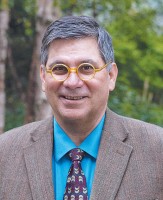Atwood chair introduces students to new model of storytelling
by Jamie Gonzales |
Mark Trahant, the newest occupant of UAA's Atwood Chair of Journalism, could be a poster child for the radical transformation of the news business.
He started his career as a print journalist. His last traditional job was at the Seattle Post-Intelligencer, where he chaired the editorial board and directed a staff of writers, editors and a cartoonist.
That was five years ago. When that corporate slot dried up and blew away, Trahant became an independent journalist, one without an institution to support him.
Now he covers what he cares about - health care, the new austerity, Native American voting - and hustles to place his work wherever he can. He expects to pick up stories in Alaska during his year here.
Trahant has had considerable success as a journalist. PBS Frontline aired his video story about child sexual abuse at the hands of a priest and deacon in the village of St. Michael on Alaska's Seward Peninsula. His coverage of Native American voting in Montana won first place in television production in a Native American journalism competition last year.
He self-publishes books and blogs and tweets frequently about topics that matter to him. He even delivers a daily Twitter poem off news headlines. "OK," he says, "maybe it's more Burma-Shave than poetry."
For the next year, this midcareer survivor will introduce UAA students to journalism's new world order, something he's witnessed from the front lines.
"The newsroom model is gone," he says matter of factly. "Journalists will be independent and work project to project, like contract workers. They'll have to be focused on the next gig all the time. Every journalist will have to become a multimedia storyteller."
He's sanguine about the decline of the business model of traditional journalism. To him it was a simple equation: "When journalism stopped making money for corporations, corporations moved on."
Trahant is a father putting two kids through college at the University of Idaho. "Yes, I wish the Seattle P-I had yielded 12 more years of security," he said, but it didn't.
Trahant is tall and calm. He's a member of Idaho's Shoshone-Bannock Tribes and former president of the Native American Journalism Association. He's earned fellowships in Italy and with Kaiser in the U.S., where he dug deep into health care issues.
He remains pragmatic about the future of journalism, telling his students there's enormous opportunity if they get in the game. They should start now.
"First, get a domain name and set up a website to showcase a growing portfolio," he says. "Create a brand. Become an expert in a topic area you can market, know it so well that no one can touch you."
Even with the loss of institutional journalism jobs, he's sure they can develop significant careers, defined by hustle. "They have so many of the skills already," he says. "And what you can do with an iPhone is amazing."
But their ability to adapt pulls from more than the latest techno gizmo or their arrival in a digital age.
"We're in a period of general deflation," Trahant said. "We now accept that our children will not have the same opportunities that we had." And those children get that, he says.
The good news for them is that Alaska is loaded with untold stories. Like this one: "The whole idea of rethinking shipping lanes in the Arctic. The narrative that stuck with climate change is the many downsides of global warming but there's been very little discourse about the opportunities it will open up."
Or the unsettled connection between the state of Alaska and Alaska Natives.
"Alaska thought ANCSA settled everything," he says. "But it left open a lot of questions. They're starting to get answered in a way that requires the state to completely rethink its relationship with Alaska Natives" with unfinished business in subsistence, child custody cases, villages as governments rather than appendages of the state and others.
I asked him how journalism schools need to change to accommodate the changes in the field. He was full of ideas.
"The same forces that hit journalism are about to hit universities," he says. "The university of the future is going to be much more certificate-based than graduate-based. You'll pick up areas of expertise, like DSLR photography, and get your certificate for it."
But where will new journalists learn values: the watchdog function, giving voice to the voiceless, speaking truth to power?
"I still teach Hutchins," Trahant says, a reference to Robert Maynard Hutchins and his 1947 University of Chicago Commission on the Freedom of Press, a project that lays out the philosophical underpinnings of a free press in a democracy.
And what message would he offer to Alaska's working journalists?
"Get away from the doom and gloom," he says. "Just because the newsroom has been around since the 1920s does not mean it will be forever. This is just a new chapter. Adapt to it."
The Atwood Chair was established in 1979 by former Anchorage Times publisher Robert Atwood.
Note: A version of this story by Kathleen McCoy appeared in the Anchorage Daily News on Oct. 5, 2013.
 "Atwood chair introduces students to new model of storytelling" is licensed under a Creative Commons Attribution-NonCommercial 4.0 International License.
"Atwood chair introduces students to new model of storytelling" is licensed under a Creative Commons Attribution-NonCommercial 4.0 International License.










